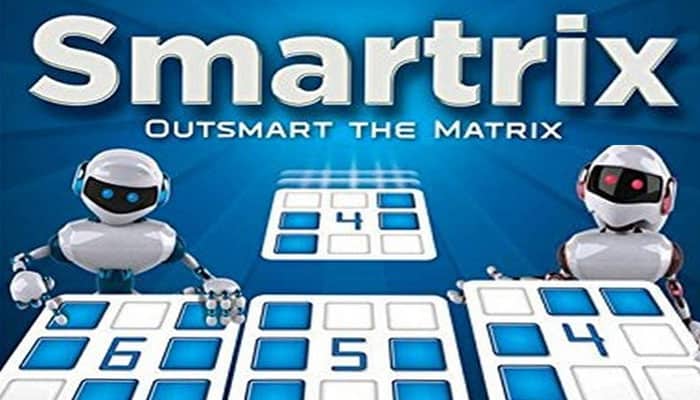
The strategy for Smartrix can be appreciated on different levels. At the most basic level, when playing the simplified version given at the end of the rules, it can be treated as a fun and simple matching game.
For experienced players, however, Smartrix provides a captivating challenge, combining memory, risk-taking, tactics, and a touch of luck for the sake of suspense.

Components
- 70 playing cards
- Instructions
Object of the Game
Players earn points every time they place a card that forms a sequence of 5 matching cards, known as a set.
When a player forms a set they collect all the cards comprising the set.
Each collected card is worth the number of points shown on it.
At the end of the game, the total value of cards collected by each player is tallied and the total value of cards that remain in each player's hand is deducted from their total score.
The player with the highest total score wins.
Setup
One player is chosen as a dealer, shuffles the deck and deals five cards to each player.
The remaining cards are placed in a single stack face down as a draw deck. A single card is drawn from the deck and placed face up at the center of the table.
Play then proceeds clockwise, starting with the player to the left of the dealer.

Game Play
Each player, on their turn, draws one card from the draw deck, then may play one card from their hand onto the table (see "Placing the Cards").
If the player cannot or does not wish to play, he or she may pass. (Passing, even when holding one or more cards that can be played, may sometimes be a smart move).
Forming Sets
When a player places a card such that a line of 5 cards (horizontal, vertical or diagonal) is formed, this is a set. The player then collects all the cards that form the set.
Sometimes, by placing a single card, several sets may be created at the same time.
In this case the player collects all the cards that form all of those sets. (Can you tell what is the maximum number of cards that can be collected by placing a single card? For the answer visit www.FoxMind.com)
Examples of sets:


Value of Each Card
Each card has around its edges 8 boxes which may contain a colored spot, or be empty.
The value of each card is equal to the number of colored spots on the card, as indicated by the number in the center.
Placing the Cards
A. Creating a Match
Each player, on their turn, places a card onto the table, so that it obeys the following rules:
The newly placed card must touch at least one card already on the table, either horizontally, vertically or diagonally.
Anywhere the new card touches another card on the table, the boxes facing one another must match - empty box to empty box, colored spot to colored spot (including the diagonally positioned boxes).
These two examples show a legal and illegal diagonal match.

These two examples show legal and illegal horizontal, vertical and diagonal matches.

B. the Playing Field
During the course of the game the playing field changes constantly as the players add cards and remove completed sets.
However, all cards on the table must, at all times, fit within an imaginary grid of 5 columns by 5 rows. In other words, no card may be separated from any other card by more than three other cards or empty spaces - horizontally, vertically or diagonally.
Note that removed sets no longer count as part of the grid - thus, after a set at the edge of the grid is removed, it may become possible to add cards in positions that would previously have been outside the grid.

End of the Game
Once the draw deck runs out, players continue to place cards from their hand. If at this stage a player passes, that player can no longer play until the game ends.
The game ends when one of the following occurs:
A player places the last card from their hand
All players have passed subsequent to the draw deck running out.
Players proceed to tally all the points they have accumulated during the game and deduct the total points of the cards left in their hands. The player with the highest score wins.
Mugging
If a player spots an illegal position (either one or more cards outside the imaginary 5x5 grid, or one or more cards not matching correctly adjacent cards), the player may, on their turn, point out the error and remove the offending cards, adding them to their score.
The player may only remove the smallest possible number of cards necessary to correct the error.
Likewise, if a player forms a set and fails to collect it, any other player, on their turn, may point out the set and collect all the cards it comprises.
Variant Rules
Simplified Rules for Children
When playing with young children, the "imaginary 5x5 grid rule" (under "The Playing Field", above) can be eliminated, making the game easier to grasp and play.
Team Game
Under this variant the game is played by two teams of two players. Players of the same team sit across from one another.
During the endgame, if one member of a team passes, both members of the team are considered finished. The opposing team may continue to play until either member runs out of cards or has to pass.
The winning team is the team with the highest combined score.
Continue Reading

